Yapping about Muramasa
Muramasa often finds itself a victim of online expectations and hype, being a universally renowned visual novel even before its English translation. Japanese players hailed it as one of the great works of literature alongside Kafka and Dostoevsky. Muramasa utilizes vertical text boxes and unique, high budget presentation to convey a very bloodlusted, aggressive story with breakneck pacing. It is the narrative equivalent of a teenager left to tinker endlessly with Gunpla and tokusatsu, the kind of story that appeals to Hearts of Iron geopolitics enthusiasts who thrive on “what-if” scenarios, or fiery purveyors of genre fiction who couldn’t care less about approval from Goodreads soccer moms. Muramasa is unapologetically a 2000s eroge, proudly celebrating its origins in Saya, Fate, and Demonbane. It revels in the legacy adult visual novels have left behind—a loving homage and sandbox for trope indulgence and unrestrained creativity.
Narahara Ittetsu is, first and foremost, an experienced kendo instructor in real life, and his two visual novels reflect a passionate investment in the art. Hanachirasu is a bite-sized revenge story that follows similar beats to the earlier Kikokugai from the same studio. However, it’s colored by Narahara’s own lived experiences and material perspective:
- An alt-history Japan as a “what-if” sociopolitical sandbox
- Swordplay becoming a viable means of combat on par with guns due to various structural reasons
- Protagonism driven by simple “Ways” (motives) that directly inform swordplay
Muramasa is an answer to the begging child asking for more helpings – somebody that’s addicted to Hanachirasu’s idiosyncrasies and wants it injected right into the bloodstream this time.
Understanding the “chuunige”
「問おう。貴方が私のマスターか?」
“I ask of you, are you my Master?” (Saber, Fate/stay night)
Coming off the success of the modest and amateurishly constructed Tsukihime and its stylish fighting game follow ups in Melty Blood, young writer Kinoko Nasu, artist Takashi Takeuchi, and the rest of the early TYPE-MOON gang aimed to make one of Nasu’s early ideas into a full-fledged product. Fate/stay night traded the Spartan worldbuilding and smaller scale for a shounen-esque battle royale, taking the otome roots of Nasu’s original idea and flipping it on its head with a seemingly standard teen male protagonist with a strong sense of justice. Fate has, on a surface level, strict rules, rituals, and mechanics that removed a level of verisimilitude and ambiguity present in older TYPE-MOON works’ spirituality. Fate helped lay out Nasu’s world in hard magic. It is incredibly fresh, fun, and unique, and yet the tropes it plays around with are fundamentally unoriginal. They are tropes every teenage boy in Japan has seen for years, and every eroge collector has experienced ten times over. That is because Fate was the first, or most notable and distinct chuunige, the simple combination of “chuunibyou” and “game”, in the same vein as eroge, nakige, and kamige.
Chuunibyou (middle-school syndrome) is a colloquialism in Japan used to describe young men with relatively mundane lives that revel in having secret abilities or interacting with grandiose circumstances in broad daylight. It is the bread and butter of battle shounen series and it’s clear to see how intriguing of a fantasy it can be – instead of a protagonist navigating an alien world to the audience, they’re just like you and have to hide that they’re special. Probably the most famous example I know of a chuunibyou character is him.
The irony of Steins;Gate is Okabe actually does have a secret ability that allows him to navigate the world around him, and oftentimes his chuuni ramblings have firm grounding in sci-fi thriller reality.
What Fate did was take these elements after prior dabbling in Tsukihime and center its entire story around a kind of day/night cycle of genre shifts. Daytime was cooking, shopping, slice of life, raising romance flags. Nighttime was brutality and intense action. This structure heightens both sides and eventually (as in most of these stories) Nasu takes a sledgehammer to the cycle and we understand it’s always both.
Needed to lay out Fate to make my point – the “chuunige” is, at its core, a bastard child of genres that don’t mix. It is the sex-fueled galge with heroine routes and ferocious irreverence and the battle royale shounen anime with adrenaline-rush convictions that don’t quite hold up under scrutiny. It’s brittle pop-utilitarianism and long Pagan chants in botched European language. It’s the 16 year old who enjoyed Kamen Rider Ryuki, Dragon Ball Z, Yu Yu Hakusho, and the like and wants to see the hot-blooded passion make its way into something that gives them a little more to chew on. It’s the desire for something a touch edgier that’s not dull and sophisticated seinen writing.
Muramasa is a story that is fundamentally and dialectically trapped in a chuunige bubble. Nobody has any chill and it is a frantic, glorious mess drunk on violence. If Fate/stay night and Tsukihime were the foundation, highlighting magic hidden in the crevices of contemporary life, and Dies irae was the reinforcement of classic chuunige tropes wrapped in pages of Also Sprach Zarathustra, Muramasa is the mindsets and philosophies of the established genre taken to its logical extreme in terms of ethics, metaphysics, and tone. Because of this bubble, it is also very well-equipped to explore and unpack common themes and ideas that span the subgenre.
One of the more immediate tricks the game plays on you is through its romance system. If you charm the gorgeous women in the game (and trust me, it’s obvious when there are opportunities to do so), they buckle at the knees and an in-game UI shows their points go up. In most visual novels, you won’t find something this blatant and overt and flags are often quiet and charted in the background. Muramasa being subtle as a brick plasters it in your face.
When it sinks in your brain that Kageaki, our protagonist, must KILL those he cherishes every time he decides to take the life of his perceived enemies, the mechanic becomes a haunting spectre.
Many players open the visual novel hoping to raise Kanae or Ichijou’s points (generally it’s Kanae as she is more well-endowed and ojousama characters are sought after) and put way too many points into one or both of them. They end up dead come around Chapter 4 as Kageaki’s love bites him in the ass and he’s forced to kill them over someone else. Even if this doesn’t happen, generally the girl out of the two that gets more romance points is the one that ends up dead, branching you onto the other’s.
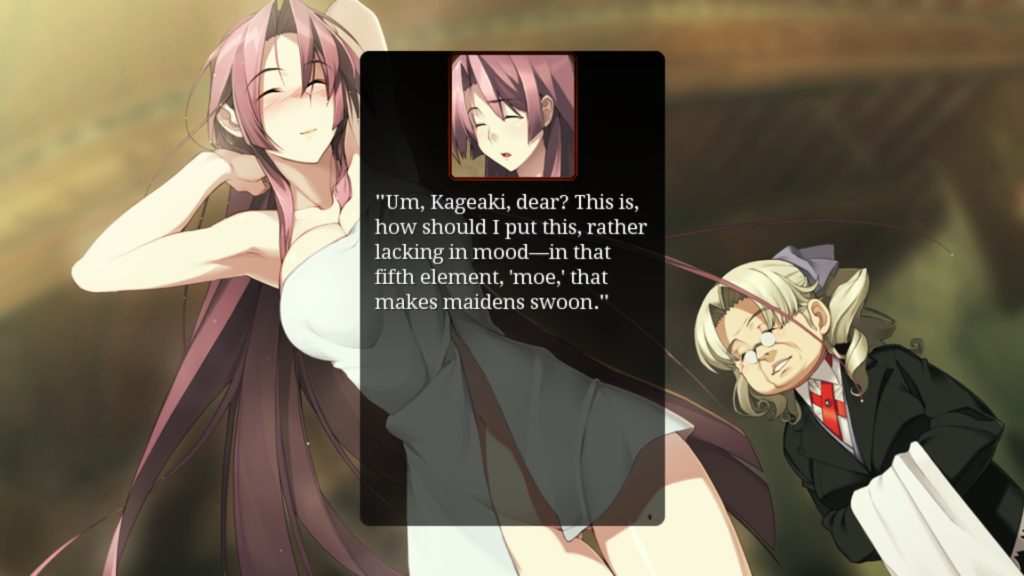
Understanding Kageaki Minato
Starting Muramasa puts you in the shoes of Yuhi Nitta, a stubborn, kind-hearted teen who feels typical for the genre at its lightest in tone. He’s not the brightest, but he’s a perfect vessel to ease you into the story. The year is 1940, British imperialism has Yamato (Japan in this world) in a chokehold, and the fascist shogunate Rokuhara has become a stopgap that imposes a cruel, autocratic rule on the country. Chapter 1 paints him and his friends as exiting the Plato’s Cave of “there are heroes” in Suzukawa and later Kageaki and throws them into the cold reality: in this story, there are no heroes. The thorough info dumps and worldbuilding paint a landscape that Yuuhi feels incredibly out of place in.
Kageaki later does the deed and slaughters the child for his own ends, quietly acknowledging his resolve and deeply respecting what he stood for. What seemed to be a comedically gloomy young man with poor posture and sickly pale skin turned out to be a reluctant mass murderer invested in politely executing upstanding citizens.
The Law of Balance is a perversion of an old Buddhist mantra:
"If you meet the Buddha on the road, kill him. If you meet a patriarch, kill the patriarch. If you meet an arhat, kill the arhat. If you meet your parents, kill your parents. If you meet your relatives, kill your relatives. Only thus will you attain liberation. By not clinging to anything, you can destroy it and pass freely."
Linji Yixuan is often attributed the stanza. The doctrine is centered around ascetic dismantlement of fixed authorities and attachments that block the path to enlightenment. In typical chuunibyou fashion, it is often bastardized as an indiscriminate and undiscerning swordmaster cutting down all in their path. Muramasa takes this literally by cursing Kageaki to his tsurugi, the gaudy, sentai-esque flying mechs with magitech abilities. Muramasa, the tsurugi, is cursed to take two lives in all her actions – killing someone Kageaki needs dead means another Yuuhi has to get picked off quietly too.
"Where there are demons, I slay them.
Where there are saints, I slay them.
Good is not my nature.
Justice is not my purpose.
The righteous path is not mine to walk.
Good and Evil alike shall perish beneath my blade."
It is deliciously edgy in a way that suits Shadow the Hedgehog, but taken entirely seriously as a governing law of Kageaki’s actions. He doesn’t revel in it but deeply hates himself for being bound to the Law. However, the Big Moral Conundrum here is his inability to stop killing as the genocidal musha Ginseigou is terrorizing Yamato with extreme murderous brainwashing and unmatched power. His sister dons the ant-shaped mech and rules through the Law of Might, and there aren’t any alternatives in his mind to stop her terror besides continue his path.
Alt-history Japan and Europe as conscious social commentary in The Bubble, tsurugi as capital
One of the distinct factors in Muramasa’s reality that allows its timeline to branch off heavily from ours is the discovery and refinement of tsurugi. In the real world, tsurugi are used to describe both swords and aircraft. As a result, the huge mechs in Muramasa take the shape of both WW2-era fighter jets and samurai garb with beautifully crafted longswords. The fusion of these elements and the magic justification means the sociopolitical landscape is drastically different in this world. Tsurugi are a long tradition of masterfully crafted art pieces and also central to the economic base of industry.
The technological benefits of tsurugi start to paint a picture of how armed struggle is conceived differently. The Americans struggled to achieve independence due to the overwhelming power of British cruxes, the Western term for the same concept. The Allied powers in general have wide reach over the world and the naval might of Britain is reinforced with a fiercely brutal air force. It has allowed the ambitious Rokuhara shogunate to take over Yamato as a whole and rule through brutal conquest – rape and pillaging.
Having a technologically advanced recreation of late WW2 gives Narahara the excuse to introduce a few major differences from our world. The wide-spanning Japanese Empire does not exist and has been neutered by an overwhelming British force in the same vein as Code Geass. Taking Imperial Japan out of the equation creates the opportunity to build a new canon navigated by aforementioned chuunibyou outlooks. This is a World War II dictated by the young men on the losers’ side, one where all conflict and motivations are extreme and heightened by circumstances. Muramasa is a “what if” sandbox for Japan before the nuke, and tsurugi helped shape the material circumstances for it to happen.
Having tsurugi be supernatural and not entirely mechanical or comprehensible through empirical means gives Yamato an edge as their old traditions and spirituality continue to shift the world landscape. The Old Way of impeccable swordsmanship is now not just reasonable, but the correct strategy to employ for most of the story. It is very intentional that Muramasa shows us bullets deflecting off tsurugi very often – the Bakumatsu era fusion of high tech and swordsmanship has come and gone, but it is not as obvious of a transition as one may expect from real life.
Tsurugi are central to the means of production in general. The industrialization of Muramasa’s world demanded the old way of shin’uchi could not sustain itself. Shin’uchi demand a soul painstakingly forged to armor and boast unparalleled individual power. However, kazu’uchi begin to make more sense with modern warfare – mass produced armor churned out soullessly and meted out to soldiers indiscriminately. Kazu’uchi find an upper hand in numbers and as GHQ (Allies) find themselves with more and more technology to play with the gap is closed. Of course, Muramasa revels in shin’uchi always still having the upper hand, in typical sword-versus-gun Japanese stories where pious tradition triumphs over brute force high-tech Western strategy. This is, again, part of a deeply ingrained chuunibyou framework the story is bound by. Muramasa herself is incredibly fucking cool in the cursed, antiquated energy of her attacks.
In a world with such fearsome power and where pure skill with a sword manifests as real social capital, in a world which insists heroes cannot thrive or exist, what if one still tried to achieve justice?
Understanding the Full Metal Providence Masamune
Ichijou Ayane is the typical hero character in her immediate traits and appearance. It is not a coincidence she is the only heroine who’s still in high school. She is incredibly straightforward in intent – there is no subtext with Ichijou, she is exactly how she appears.
Her name’s kanji help reinforce this idea.
綾 - “aya” - refined beauty, elegance
弥 - “ne” - viral growth and flourishing
一 - “ichi” - “one”, “first”, unified, primary, focused
条 - “jo” - “path”, “line”
What, pray tell, is more beautiful than an innocent dream for justice in hell? The young girl finds herself barreling towards a seemingly impossible goal – to rid the world of evil so only beauty remains. What makes Ichijou different is the insistence on good and evil as abstracts – she has a genuine obsessive focus on dismantling Evil and will tirelessly fight under this unique selling point regardless of who dies. This is the crux of Kageaki’s frustration and what, in his mind, labels her a demon. Muramasa insists, consistently, that Ichijou’s aims are utterly miserable and leave her in pain.
As the archetypal hero, she takes inspiration from Japanese pop culture and the eroge subculture specifically. Kamen Rider is the keystone block that defines all the tropes in her character. Ichijou’s most famous art piece in the game shows her bright red scarf-like clothing piercing a sunset backdrop. Like many Riders, she finds herself having to give up her own happiness for the sake of pursuit of justice. She develops a huge crush on Kageaki and the challenge is being able to reconcile these feelings towards a man she looks up to with the crushing reality that low-effort movie dates with him will not hide the blood on his hands.
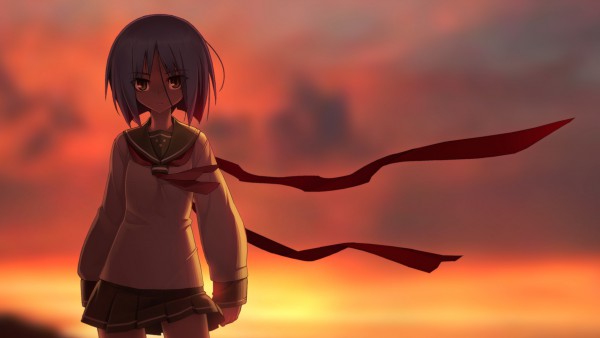
Kageaki is evil. He must be brought to justice.
While Fate/stay night’s level influence from tokusatsu is questionable at best (it is more likely many of these established tropes found themselves floating in public consciousness), the pains of heroism are the center of its story and is probably the visual novel most in line with Muramasa in its framing of heroes as tragic figures selling away their humanity. Shirou is a victim of a violent fire that took his old life, parents, and sense of self. He is reborn as an Emiya, adoptive son of the failed hero Kiritsugu. Emiya Sr. is a vicious utilitarian who committed his adult life to achieving a better world through violence. A young Shirou saw the life he led through his own rose-tinted glasses, and with a combination of survivor’s guilt from making it out the fire and admiration for his father, decides to become a hero of justice.
Shirou is unnatural in his behavior – after being stabbed and waking up from a prior injury, his first thought isn’t even caring slightly about his body but looking for a mop to clean up his mess. He has absolutely zero regard for his own health and operates through altruism. His heroism is represented by “sword”, and for various reasons within the story this manifests as a magical affinity. In the second route of F/SN, Shirou manifests an internal world full of swords that he can invoke to overwhelm enemies, highlighting his acceptance of his identity. Later, in the final route, these same swords begin to involuntarily replace his organs and bones, causing excruciating pain he must endure for a certain end. The body horror becomes a lasting symbol for what heroism does in practice and the tragedy involved.
Ichijou is shockingly similar in how she operates. Her father was a good-natured politician whose refusal to entertain evil left him drowning among moral dilemmas, unsure how to mete out punishment while still being in the right. This eventually leads him to literally die at the hands of Ichijou via sword because of his own self-loathing. Her foundation in pursuit of justice is “stolen”, and she is tasked with the decision of either abandoning it or holding it above all else, like she did when murdering her own kin. When donning the fabled tsurugi Masamune, he is willing to literally distort and destroy her body as a weapon, smashing ribs and organs into energy blasts (and, eventually, Lovecraftian horror). They enable each other on a destructive path, but her conviction does not let her leave.
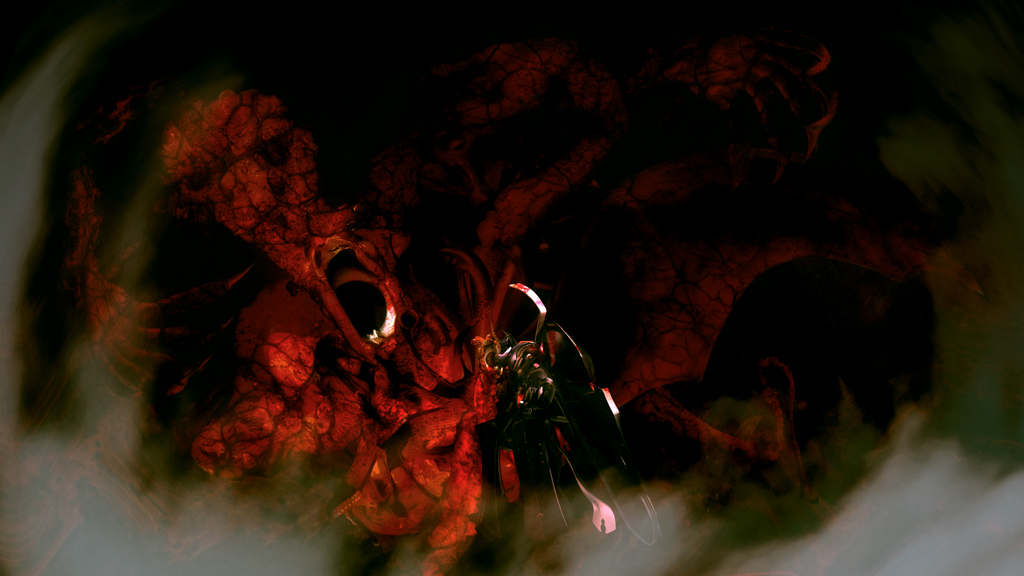
A piece of important context often missed when engaging with Muramasa are the ways in which it is an evolution and acknowledgement of past Nitroplus stories in its character writing. Deus Machina Demonbane is the literal opposite of Muramasa in every way. Daijuuji Kurou is a reluctant hero who finds himself resilient by the end, and there are clear and apparent threats in lieu that are unambiguously worth taking down.
Kageaki is the lingering feeling in the back of your head when engaging with stories that espouse simplistic morality – especially those where humanity finds themselves trouncing an insurmountable unknown force or nondescript enemy. The crimson pilot, in his guilt-ridden self-hatred and deep disgust for murder, thinks the rampages spurred on by “heroes” are deeply disgusting and harmful. It is a snap back to reality highlighting how the blood-pumping super robot narratives about crushing all in sight are not materially relevant for a story about Ally-occupied Japan.
-
The British believe they are right in their technical superiority, and kill and slaughter for this end.
-
The Americans believe they are right, and plan to backstab the British for their American Dream.
-
The Germans believe they are right, and want scientific domination of the field of tsurugi and cruxes for their Social Darwinist ends..
-
The Rokuhara Shogunate believes they are right, as through combat prowess and fascism they have become a geopolitical force that can keep Yamato free of whites.
-
Ginseigou and Hikaru Minato believe they are right, as through mass genocide they can achieve sole control of the world akin to a god, representing the infallible Law of Might.
-
The men spurred on by Ichijou’s words – the words that seek to achieve a better world – are still immaterial strokes of violence that leave children dead and families broken. Kageaki wants to subsume himself into Ichijou’s goals as well. Allow the girl to kill for you and avoid the Law of Balance.
But none of these are justice. Kageaki finds himself deeply disgusted with the notion that any social or political movement can claim to be anything but a pack of demons willing to slaughter for their ends. He correctly assesses the futility in constructing revolutionary power through moralism, deciding to dismiss the efficacy it often has in causing real change. This is the relationship between the man and the woman – one aims for a resilient struggle towards a better world through benevolent idealism and the other squashes any revolutionary sentiment because of a paranoid fear of self-righteousness. Ichijou and Kageaki are dialectically trapped in the chuunige. There is no third way, there is no “out”, because in the collective mind of Muramasa there is only obsessive violence. It is a prison devoid of any class conscious thinking (most likely, this is not intentional but just quietly reflective of Narahara’s own worldview).
This route is genuinely one of the most incredible things to hit the entire medium of visual novels. The lectures through the lens of Kageaki’s moral relativism are a little overwrought, but the fights and presentation are life-changing.

You know, we could all be reading a book right now.
The hero cannot thrive in a story such as this without a caveat, and in the end, both Ichijou and the worn down tsurugi Muramasa are the ones that survive. Ichijou keeps her undying wish for justice, but now she is bound hopelessly by the need to slaughter one of her own. The quiet revolutionary spirit has been put out, she is now just another cog in the murder machine. She looks back at the late Kageaki in spirit and refuses to leave her path, as the man who stared her down adamantly refused to entertain it.
Hero Route is in love with the loud, lofty declaration of ideals and finds itself drowning in its lack of grounding in material reality. The central conflict is a moralistic farce Kageaki and Ichijou force themselves into as it is all they know and can operate around. It is tragic in its lack of solace, but glorious in how grandiose and downright fun it is to watch unravel.
Understanding the Nemesis: Kanae Ootori
Kanae’s route is a stark contrast that works best as a bookend to the ideas espoused in Hero. Nemesis Route engages with the futility of revenge and dissects the psychology behind one that continually pursues it. In the same vein as Ichijou being the “hero” in its purest form juxtaposed against heightened tensions, Kanae is the “nemesis” in a world that equips her with the means to mete out her vengeance at a large scale. Rather than having aspirations for a grand ideal, what about killing for the sake of an eye for an eye? Kanae Ootori presents herself early on as a beautiful, well endowed young woman that entertains Kageaki in strides with aggressive flirting and manic outbursts. She has an odd pixie girl personality that is revealed to not be a front but simply a facet of a deeply broken woman boxed into roles she could never fulfill. The only comfort she has is confiding in the Law of Vengeance.
The most substantial bits of thematic heft in Nemesis center around Kanae, as the overarching story isn’t taken as seriously by involved actors. She wants Kageaki dead after the man took her cousin’s life. This becomes a particularly outstanding vendetta in the woman’s mind as unlike many of the other bouts of vengeance she follows through on, she has tangible emotional stakes. This arguably makes it harder for her to commit to the Law, as Kanae takes pleasure in the cold detachment and brutality of being a Japanese Punisher. Kageaki is elated when she comes to execute him out of revenge, promising a slow and painful death after the political tensions in the narrative die down. Kanae is very difficult for him to properly read and understand and masks her thoughts in joke-flirting, while Kageaki wears his feelings on his face and conveys them very well through posture. With the main threat of the entire story reduced to a melted blob of metal, there is nothing here but a vengeful woman, two empires dying to her hand, and a man watching her burn everything down.

Kanae properly distills the vengeful actor in shounen-esque and chuunibyou narratives, not just by embodying the futility of vengeance, but through her stark and unsettling self-awareness of it. The narrative deliberately deflated external stakes through the overwhelming supernatural ability the woman enjoys. There is a deep, weighing feeling of regret she feels as more and more of what’s dear to her is dismantled with her own two hands. Between Shishiku and Kageaki, her reluctance to follow through on murder framed by the story is akin to a demon growing a human heart. What Kageaki incites in her is reluctance, but it is unfortunately too little, too soon. They follow through on a tragic double suicide as Kageaki kills one he deems good and one he deems evil at once through the same woman, and as Kanae hangs herself by her own refusal to come clean about who she is behind the armor.
Understanding the Broken Family
Uemon-no-Jo Muramasa III is a victim of her overzealous grandfather and mother. Grandpa Muramasa valiantly espoused the idea that all violence and murder is equal, and reinforced it as a means to discourage violence everywhere around the world. In his weird, twisted activism, Muramasa II was born and further brought terror to everyone around them with indiscriminate killing. After hitting adulthood, Muramasa III negotiated to have herself and her mother fused into tsurugi to contain the insurmountable threat they presented. III is designed first and foremost to be able to destroy her mother, donning a red spider as her appearance.
Centuries later, the strict Minato family struggles as their next-in-line deals with crippling lead poisoning and could die at any moment. Hikaru Minato is the tragic product of adopted son Kageaki and mother Subaru. Kikuchi Minato, Subaru’s husband, received a debilitating injury to his genitals in war and as a result could not extend the Minato bloodline himself. Instead, he and the old Minato patriarch give the adopted Kageaki an aphrodisiac and have him sexually assault his own mother.
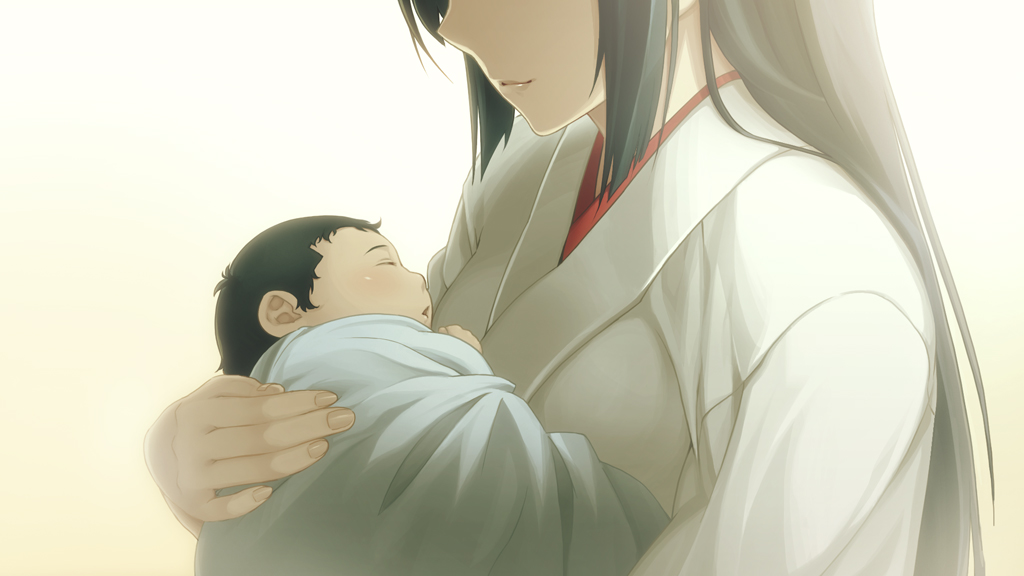
After Hikaru’s birth, Subaru insists Kageaki must never acknowledge Hikaru as his daughter. They are for all intents and purposes siblings, and he is tasked to look after his sister. Kageaki memory holes the events and unreliable narration omits them consistently, showing quick flashes to the sex he had with Subaru during the other H-scenes. It is the reason behind his aggressive behavior in bed. Hikaru understands the relationship she has with her father and because she is so materially limited, being sick and bedridden from recent lead poison and never able to love her father, she has a strong, deep desire to dream, to aspire to be better than who she currently is. As Hikaru comes into contact with the suspicious looking tsurugi housed in their shrine, she bonds with Muramasa II and begins her genocidal rampage, dreaming for a world where she is acknowledged. Kageaki finds himself forced to kill his mother by equipping Muramasa III and killing another tsurugi who threatened their lives. With nothing left for him, he tirelessly chases after his daughter before she ends the world in a cursed tsurugi.
Muramasa III is a very straightforward woman in that she largely aligns herself with Kageaki and just wants to see him happy and fulfilled. She has a level of jealousy towards the other heroines in their routes as she wants nothing more than to exist alongside him, but the duality in identity between the two prevent a deeper bond in combat. They are partners, and neither is a tool. As she manifests herself to an approximate human form, it becomes even more obvious they can never go back to being emotionless assets for each other. She is clearly the “final” or “default” heroine in typical chuunige fashion and while there is no clear subversion, it is a clear and loving call back to Kurou’s partner Al Azif in Demonbane, a literal book called the Necronomicon manifested as a young woman.
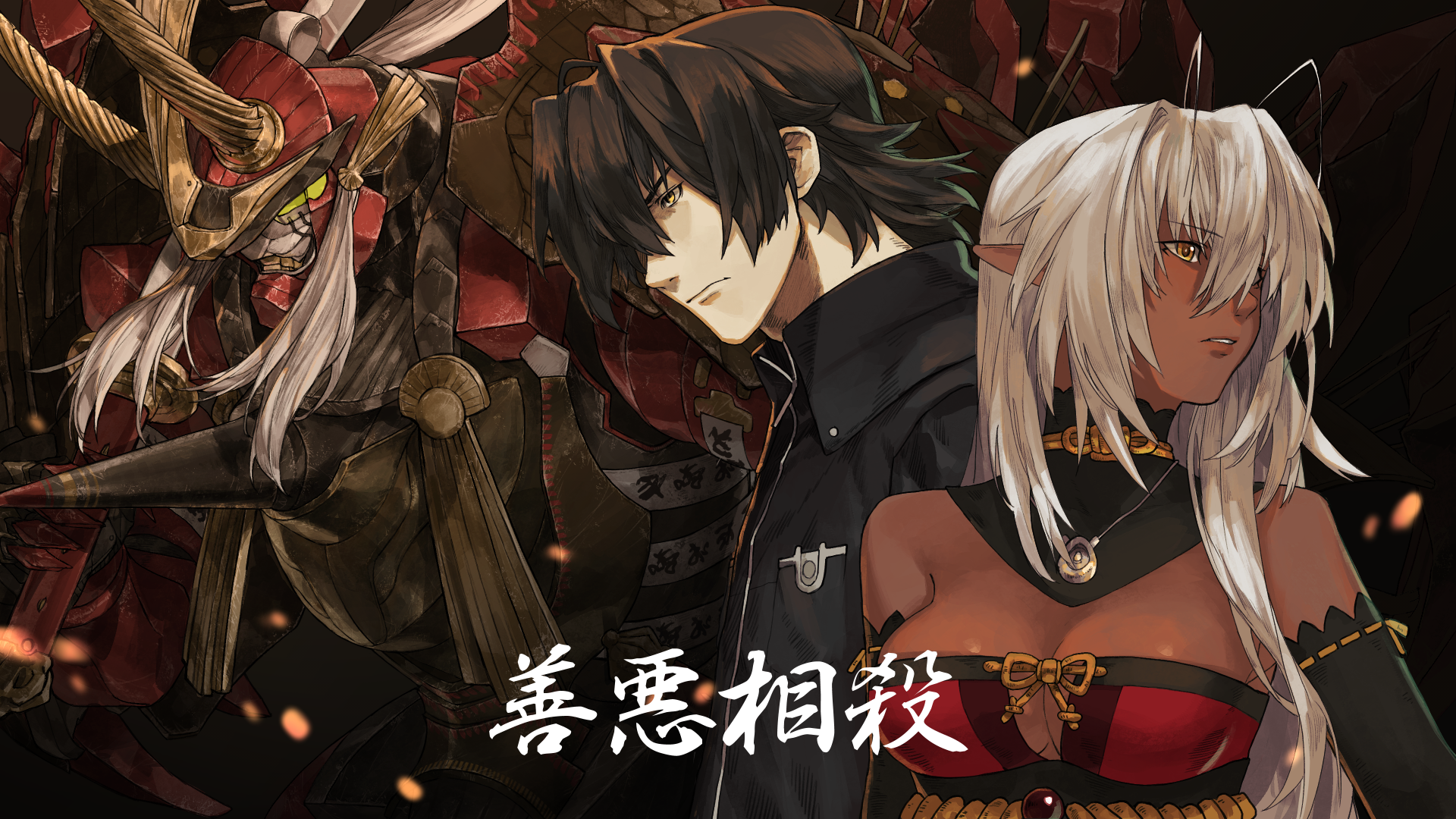
Art by kyotyan
Understanding Chachamaru Ashikaga
Chachamaru presents another option for Kageaki: what if he threw all of it away. The man is downright miserable, misguided, unsure of how to truly stop Hikaru on his own with her new power in the final route. He has doubts and pains and noise stopping him from living a fulfilled and purposeful life. The young Rokuhara general is able to tempt Kageaki and corrupt him with one of Ginseigou’s eggs, removing all doubt in his mind in favor of a simple love for Hikaru. This Kageaki, unlike the other victims of Ginseigou’s eggs, doesn’t go insane but instead is calm and vicious. He’s irreverent, smug, and lascivious, quietly hinting at the idea the Kageaki he allows us to see isn’t quite the whole picture. If Kageaki is sane now and his mind is at peace, what was he for most of the story? The incredibly confidently edgy Kageaki fits his role in the chuunige like a glove, being an effective Rokuhara aide alongside Chachamaru and ruling with an iron fist.
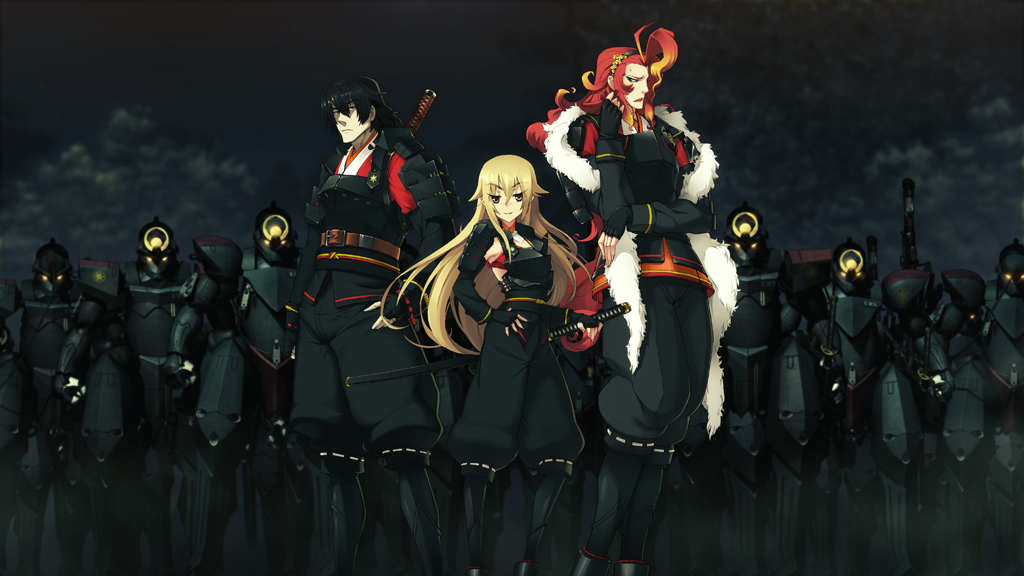
Chachamaru herself is the bastard child of a forcibly impregnated mother and the powerful Morimasa Ashikaga. To get rid of the pregnancy, Morimasa had the woman fuse herself into a tsurugi, but what came out was a human/tsurugi hybrid, living in constant pain and noise. As the mindless tsurugi god is invoked, Chachamaru suffers from information overload slammed into her brain. Tsurugi binary I/O is inherited by her human brain and it comes across like unbearable noise constantly. She fits the glove of burn it all down character within the chuunige setting in her insistence on killing “God”. Through Kageaki’s brief stint losing his identity and the time they spend together, the two achieve a strong bond and help bring fire and brimstone to all of Yamato for the sake of awakening the Konjin.
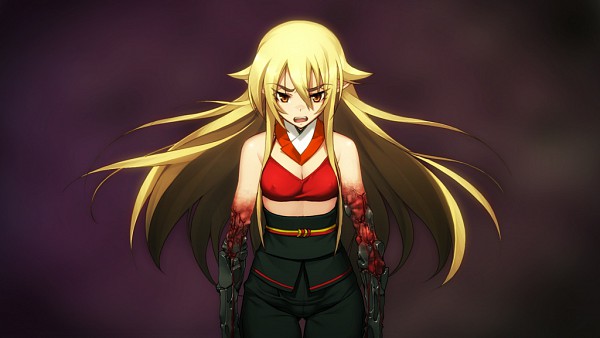
Reclamation of identity: understanding the Full Metal Daemon Muramasa
As Muramasa III breaks Kageaki out of his corruption and mind control, the doubts and reserves and guilt he has return and he becomes his normal self, revitalized with love for the woman and a desire to end his daughter. Throughout the finale, the man still struggles to meet his daughter in combat and yet pushes through with simple acknowledgement of the Law of Balance – as he loves Hikaru and hates himself, the Law is fulfilled and Hikaru dies in peace. Kageaki stabs himself in the chest to commit suicide.
The strong sense of duty that binds him is quite uncharacteristic for action-chuunige protagonists, but it makes Kageaki who he is. As his tsurugi heals him, it is then evident he is not free. Trying to chase after peace as a civilian leads people to notice something is wrong with him. He can’t accept who he is and lives every day wallowing in sadness. By the end, what saves Kageaki is not stubbornly keeping to himself and leading a normal life, but playing into the role of “villain” as Kanae Ootori and Ichijou Ayane approach him and want his head. Minato Kageaki has died, and the warlord, the full metal daemon Muramasa has been born. Kageaki finds his proper space in the chuunige framework as a bloodlusted villain, unable to break out of the extenuating circumstances of an edgy Nitroplus eroge.
Muramasa argues self-righteousness is futile and dangerous to operate by, encouraging a more critical examination of political movements and grand ideals used to shape history. It often comes across as shockingly cynical, highlighting the hopelessness inherent in a political bubble of false consciousness. The unspoken hope is that our own world can acknowledge the pitfalls of 1940s Yamato and truly pursue peace – to distill war down to its roots and cut it down promptly before it leaves more dead.